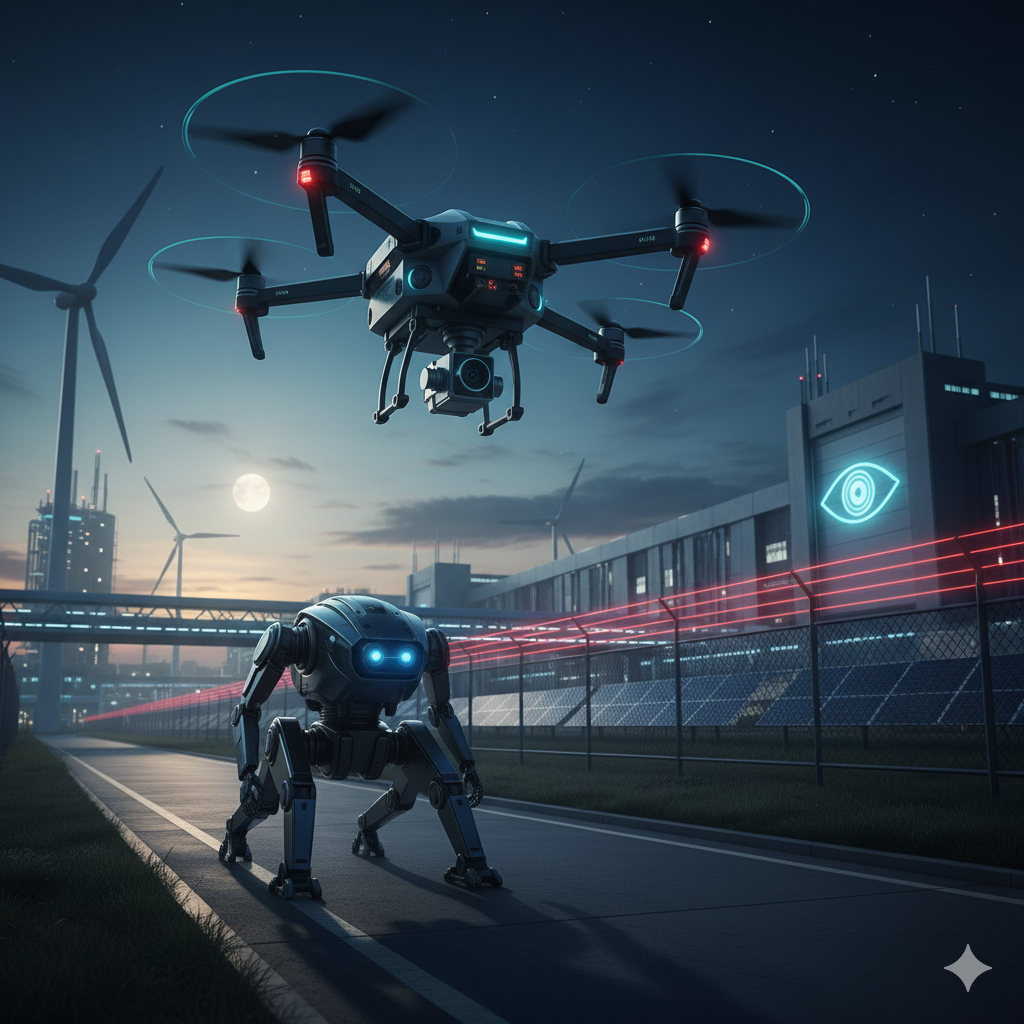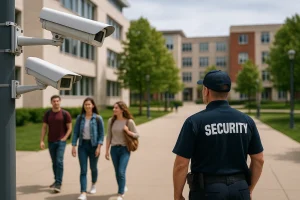Drones and Robotics: The Future of Patrol and Surveillance
From airports to smart cities, drones and robotics are reshaping patrol and surveillance. This in-depth guide covers current applications, global case studies, benefits, challenges, and the role of AI and IoT in shaping future security systems.
By David Kerolles
September 18, 2025

Introduction: Why Drones and Robotics Are Changing Security
Traditional surveillance relied on guards, cameras, and patrol vehicles. While effective, these methods are limited by cost, human fatigue, and coverage restrictions. Enter drones and robotics—technologies that expand reach, improve safety, and offer continuous monitoring.
Global adoption is accelerating. According to market reports, the security robotics market is projected to surpass $4 billion by 2030, with drones accounting for a major share. Governments, corporations, and even small businesses are integrating these tools into their operations.
In this expanded guide, we’ll explore real-world examples alongside trends, benefits, and challenges shaping the future of patrol and surveillance.
The Role of Drones in Modern Surveillance
How Drones Are Used in Security
Drones, or UAVs, have become indispensable in:
- Border security: Used by the U.S. Customs and Border Protection to monitor thousands of miles of borders.
- Disaster zones: Deployed in Turkey and Syria after earthquakes for search and rescue.
- Event safety: French police used drones to monitor crowds during the Paris Olympics.
- Critical infrastructure: Energy companies like Shell deploy drones to inspect pipelines and offshore rigs.
Case Study: Police Drones in the U.S.
The Chula Vista Police Department (California) operates one of the most advanced “drone as first responder” programs. Drones are dispatched to 911 calls before officers arrive, providing live video feeds. This reduces response times and improves officer safety.
- Result: Over 10,000 flights completed, with drones often resolving situations without dispatching ground officers.
Case Study: China’s Smart City Surveillance
Chinese cities like Shenzhen deploy drone fleets integrated with facial recognition and AI. These drones monitor traffic violations, illegal gatherings, and even environmental hazards.
- Result: Faster law enforcement responses and improved public safety, though privacy debates are ongoing.
Robotics in Ground Patrol and Surveillance
Current Deployments
Security robots are being tested worldwide:
- Shopping malls and corporate campuses: Knightscope robots patrol U.S. facilities, capturing 360° video and detecting suspicious activity.
- Airports: Seoul’s Incheon Airport uses autonomous robots to guide passengers and monitor restricted areas.
- Universities: Carnegie Mellon University deployed robots to monitor campus walkways at night.
Case Study: Knightscope Security Robots
Knightscope’s K5 robots operate in parking lots, malls, and business campuses across the U.S. Standing over 5 feet tall, they use AI, cameras, and sensors to patrol autonomously.
- Result: Clients reported reduced crime rates in areas where the robots are deployed.
- Challenge: Some public backlash occurred when people perceived them as invasive or ineffective in certain scenarios.
Case Study: Dubai Police Robo-Cop Initiative
Dubai introduced the world’s first robotic police officer in 2017, capable of interacting with the public, scanning for threats, and reporting incidents. By 2030, Dubai aims for 25% of its police force to consist of robots.
AI, IoT, and the Future of Autonomous Security
Technology Integration
The next frontier in surveillance is AI-driven autonomy, where drones and robots act as part of a connected security ecosystem.
- AI Analytics: Identifies suspicious behavior, abandoned objects, or unusual movement.
- IoT Networks: Connects drones, robots, and smart cameras into one platform.
- Predictive Security: Uses big data to forecast risks and deploy resources proactively.
Case Study: Singapore’s Smart Nation Project
Singapore integrates drones, ground robots, and AI cameras into a nationwide network. These devices help enforce COVID-19 restrictions, monitor public safety, and manage traffic.
- Result: Enhanced efficiency, though civil liberties groups warn about surveillance overreach.
Case Study: Military Drone-Robot Collaboration
The U.S. Department of Defense invests heavily in swarm drones and ground robotics for battlefield surveillance. Autonomous systems coordinate to map terrain, detect threats, and protect troops.
Benefits of Drones and Robotics in Surveillance
- Expanded Coverage – Access remote and hard-to-reach zones.
- Cost Efficiency – Reduce manpower needs for repetitive patrols.
- Operational Safety – Keep human guards out of dangerous areas.
- 24/7 Monitoring – Robots and drones do not fatigue.
- Real-Time Data – Live analytics enable faster decision-making.
- Deterrence Effect – Visible robotic presence discourages crime.
Limitations and Challenges
Despite their promise, challenges remain:
- Battery and mobility limits – Most drones last under 60 minutes; robots struggle with stairs or rough terrain.
- Privacy concerns – Citizens worry about constant monitoring and misuse of data.
- High upfront cost – Advanced robots and AI integration require heavy investment.
- Cybersecurity risks – Hacked drones or robots could pose national security threats.
- Legal regulations – Airspace restrictions limit drone deployments in many countries.
Ethical, Legal, and Privacy Considerations
The adoption of drones and robotics sparks ongoing debates:
- Surveillance vs. privacy: Where is the line between safety and intrusion?
- Job displacement: Will autonomous systems replace human security guards?
- Bias in AI: Automated surveillance could amplify bias in policing.
- International regulations: Differing drone laws complicate cross-border adoption.
Human Input Suggestion: Include a quote from a privacy law expert or an ethicist to add authority here.
The Hybrid Future: Human + Machine Collaboration
While some fear full automation, the future is hybrid. Humans bring judgment, empathy, and ethical reasoning, while machines provide persistence, coverage, and efficiency.
- Security officers will increasingly shift into supervisory roles.
- Machines will handle dangerous, repetitive, or large-scale monitoring.
- Collaboration ensures balanced safety with accountability.
Example: In many U.S. police departments, drones are now used to support, not replace, officers—reducing risk while keeping human oversight central.
Conclusion: A Smarter, Safer Tomorrow
Drones and robotics are no longer experimental—they are mainstream in security, policing, defense, and corporate surveillance. Case studies from California to Singapore prove their effectiveness, but adoption must balance efficiency, ethics, and privacy.
As AI, IoT, and robotics continue to advance, the security sector is heading toward smarter, more autonomous systems—where humans and machines work side by side to protect people and property.
Related Posts
Training
Prevent costly mistakes and liability with a structured security guard training program. Learn how to set role-specific outcomes, choose the right training formats, and keep certifications organized for maximum compliance and client trust.
By Catherine Shannon
August 7, 2025
Cyber Security
From stopping cyberattacks before they happen to creating hyper-realistic deepfakes, artificial intelligence is reshaping the world of security. This article explores the dual nature of AI, examining its powerful role as a guardian while uncovering the emerging threats it poses to corporations, governments, and individuals.
By Anonymous + Gemini
August 9, 2025
Safety
2024 is looking to be a tumultuous year for the United States. What are the developing national security risks and threats to America, along with their security implications in 2024? The foremost specialist in regards to any security threats against US national security is the Department of Homeland Security. The Department of Homeland Security (DHS) […]
By Catherine Shannon
February 25, 2024





